Published
on 28
Dec 2015
|
All rights reserved.
|
|
7 years ago I wrote this in my Renault Megane III report:
“To keep Renault alive and the
French in the driving seat of Renault-Nissan group, the new generation
Megane has to succeed. But can it?”
Now we know the answer is negative. Megane III continued the declining
sales trend of Megane II. If anything, it declined even faster.
Although Renault no longer provides sales breakdown, we know last year
it sold 275,000 units of Megane and Scenic combined. This mean the
Megane dipped below the alarming 200,000 units mark. In other words, it
trailed all of its key rivals, let alone the best selling Volkswagen
Golf which sold 1 million units in 2014.
The Megane was not alone on the list of unpopularity. Basically, all
the traditional nameplates of Renault suffered from pretty much the
same
fate. Laguna sold so badly that it was killed and replaced by the
larger Talisman. Clio, although still shifting in relatively large
numbers, is no longer as popular as it used to be. Nevertheless,
Renault is more successful in catching the trend of small crossovers
with Captur, and its investment in Dacia is proved to be
smart – incredibly, sales of Logan, Sandero and Duster combined
exceeded 1 million units last year! Predictably, Carlos Ghosn would
rather invest more into what can really make money, whereas
unprofitable models like the Megane have to find ways to cut cost.
That is why the firm decided not to develop a dedicated C-segment
platform for Megane this time around. Instead, the new Megane IV is
reshuffled and grouped with the company’s larger cars, such as
Talisman, Espace, Kadjar and Nissan Qashqai, sharing the Common Module
Family platform CMF-C/D of Renault-Nissan group. Don’t worry about
elevated
cost.
Renault said the enlarged scale of economy allows the car to add big
car features without pushing up costs. Moreover, Renault’s large car
platform is not as sophisticated as you might think. For example, it
still employs cheap torsion-beam rear suspension, something even many
C-segment rivals have already abandoned. Carlos Ghosn just won’t let
loose on cost control.
However, sitting on a big car platform means the new Megane is quite
heavy. Because the key common parts have to be strong enough for its
larger siblings, there is little room to cut weight, even though it
follows the industrial trend to use more high-strength steel. As a
result, the new car weighs about the same as the old one thus is on the
heavy side of the new class norm. No wonder Renault did not mention
weight saving in the press release.
On the plus side, the new Megane has two things improved markedly:
styling
and build quality.
This is a very handsome car, finally something we expected Laurens van
den Acker to achieve since he joined Renault 6 years ago. I like its
new front grille and the way it focuses on the enlarged Renault logo.
The C-shape headlights are striking, injecting a sense of excitement to
the
otherwise normal body shape. The slim taillights are elegant, as is the
treatment of the whole hatchback rear. The rear passenger doors kick up
at the trailing end to enable a sportier appearance. Finally, the
bonnet and fenders are sculpted perfectly to deliver the right balance
between elegance and sportiness. Yes, the right balance is what makes
it so appealing.
The new exterior design uses quite a lot of chrome to deliver a quality
feel. The tight panel gaps have the same visual effect. Inside, no
matter the dashboard design or materials you will find the Renault
tries very hard to emulate Volkswagen. Well, it’s not exactly there,
because soft touch plastics don’t cover the lower surfaces and the
center console as do in the Golf, but the Megane compensates with some
big-car features, such as an iPad-style 8.7-inch portrait touchscreen,
TFT instrument, color HUD, ambient lighting and even ventilated
and massaging seats! Admittedly, the R-Link infotainment system is
still flawed, blame to unfriendly user interface and slow touchscreen
response. However, space is abundant. Thanks to stretching the
wheelbase to 2669 mm, the new car offers 20 mm extra knee room for the
rear passengers. Both front and rear rows get more shoulder room, too.
This means the Megane is finally a decent people carrier. Besides, the
434-liter boot is big for the class.
As usual, the Megane is biased towards comfort rather than driving
excitement (at least until the release of RS model, which is still 18
months away). Its cabin feels hushed on the move. The soft-setting
suspension results in a ride quality French cars deserve. The seats are
plush and comfortable. It grips and balanced quite well in corners, but
the steering is devoid of feel and the chassis never feels sharp enough
to thrill. It won’t threaten Ford Focus, Mazda 3, Golf or Seat Leon for
driving dynamics.
Its powertrains have much the same quality. The best seller is likely
to be the 130 hp 1.6dCi turbo diesel. It is punchy and refined at low
speed, but despite of a 5200-rpm redline, it sounds coarse and noisy
once it has passed the 4000 rpm power peak. This means in normal
driving it feels perfectly sweet, but it won’t encourage you to stretch
it. On the petrol side, Renault’s 1.2TCe direct injection turbo engine
is also more about refinement and flexibility than a spirited top end.
Later on there will be a sequential twin-turbo version of 1.6dCi with
165 hp.
Hopefully it could satisfy more demanding divers.
Until the arrival of RS, the fastest Megane is the 205 hp GT. Its
1.6-liter turbo motor comes from the smaller Clio RS. Like the latter,
it employs a compulsory EDC twin-clutch gearbox, but in this case it
has 7 ratios. As we have found on the Clio RS, this powertrain combo is
disappointing. The engine produces a terrible noise when it approaches
the 6400 rpm redline. It sounds as if begging you to back off.
Even the artificial noise produced from the speakers cannot mask it.
The Getrag-built EDC gearbox remains sluggish and inconsistent, much
less satisfying than a proper manual box. Moreover, the Megane GT
weighs nearly 1400 kg, so its performance is lukewarm, even though the
official figures look good (143 mph top speed and 0-60 mph in 6.7
seconds). It goes without saying this is a "warm hatch" rather than a
true hot hatch, much in the same way as Peugeot 308GT.
Apart from powertrain, the GT also gets a sportier chassis tuned by the
Renaultsport division, such as stiffer suspension, faster steering rack
(just 2.3 turns lock to lock), bigger brakes and smart-looking
twin-square exhaust pipes (pictured above). Furthermore, it gets the
“4Control” 4-wheel-steering system from the late Laguna GT. It adds an
electric motor and a pair of toe control links at the torsion beam rear
suspension to facilitate rear-wheel steering. At low speed the rear
wheels turn slightly at opposite direction to enhance agility, whereas
at higher speeds it turns to the same direction as the front wheels to
enhance stability. The principles are just the same as similar stuffs
on Porsche, but its tuning is poorer. At tight corners it steers
over-eagerly to the extent of edgy. In changing conditions the switch
between oversteer and understeer could be unpredictable and
counterproductive. Moreover, it kills the chance of lift-off oversteer,
which is ridiculously available on lesser models, so it is actually
less fun to drive. Besides, the 4Control hardware adds a ridiculous 39
kg to the car (the RWS of Ferrari F12tdf adds only 5kg). Unfortunately,
it is fitted standard on the GT thus you cannot skip it. No problem,
you can simply skip the car.
If we are talking about the Megane GT alone, it would be worth only 3
stars, and this is mostly because of its styling and build quality
rather than its powertrain or chassis. However, the rest of the Megane
range is better. For less committed drivers it is a more stylish
alternative to Golf or a better value alternative to Mercedes A-class.
The big-car strategy might work this time.
|
Verdict:     |
Published
on 25
Aug 2018
|
All rights reserved.
|
|
Megane RS
|
|
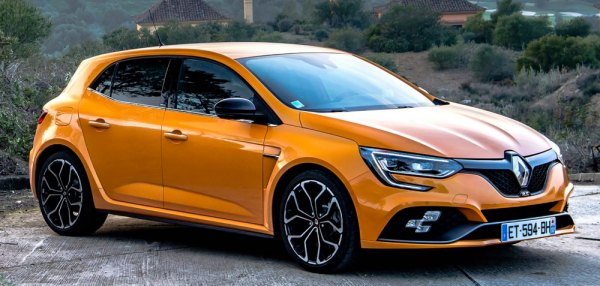
|
|
A
1.8-liter engine, 4WS and no adaptive dampers mark the new Megane RS
out from competition, for better or worse?
|
|
Remember how the current
Clio RS threw away its mini hot hatch crown? In the name of broader
customer appeal, it turned the car softer and less involving, handling
the crown to Ford Fiesta ST. We fear the Megane RS could follow the
same fate. You know, the last generation Megane RS was widely acclaimed
for driver engagement, real-world speed, a beautiful styling and simply
everything cared by keen drivers. It occupied the top spot of a very
competitive class for 5 years at least, and was only challenged by Ford
Focus RS and Honda Civic Type R in the final year. 3 years ago, when we
saw the current generation Megane in mass production form, our fears
grew further, because it did get bigger, more comfort and
refinement-oriented. Nevertheless, this year’s Alpine A110 gives us
hope. It shows that Renault is still able to design a car focusing on
pure driving pleasure, something beating even Porsche 718 Cayman! And
better news, the same experts are responsible for developing the new
Megane RS. So what is the outcome?
Before answering this question, let’s go through its various facets:
Styling: like the
regular Megane, it is now 5-door only, and the proportion gets boxier,
more conventional, unlike its coupe-style predecessor. However, Renault
keeps the damage to the minimum by using elegant design elements, such
as F1-style front blade, chequered flag-style LED lights,
double-diffusers and a centrally mounted trapezoidal exhaust. The alloy
wheels are also unusually stylish. It won’t turn heads as much as the
old car, but it is still one of the best looking cars in its class.
Cabin: not as good
as exterior. Although the RS looks smarter with some red and alloy
accents, its Alcantara bucket seats are not as enveloping as they look.
Its driving position, placement of pedals and adjustment of the
steering wheel are not perfect. Quality feel is hampered by some rough
edges and a cheap infotainment system.
Engine: curiously,
the engine is downsized to 1.8 liters, smaller than most rivals. It is
a further development from the Alpine A110 engine. Thanks to direct
injection, a twin-scroll turbo and plasma spray coating on cylinder
bore, it manages to squeeze out more horsepower and torque than the old
Megane RS275, with 280hp and 288 lbft on tap. It can also spin a little
higher to 7000 rpm, although you won’t get much reward to do so, as the
torque curve peaks at 2400-5000 rpm and the power peaks at 6000 rpm.
It’s significantly more powerful than the Alpine’s, but that car weighs
300kg less! It is a little more powerful than Peugeot 308 GTi and
Hyundai i30N, but the hottest versions of Civic, Golf and Leon have it
beaten convincingly, which is also shown in the Renault’s 0-60mph time
of 5.5 seconds. That said, a 300hp Trophy is on the pipeline, and
probably more to come from Trophy R.
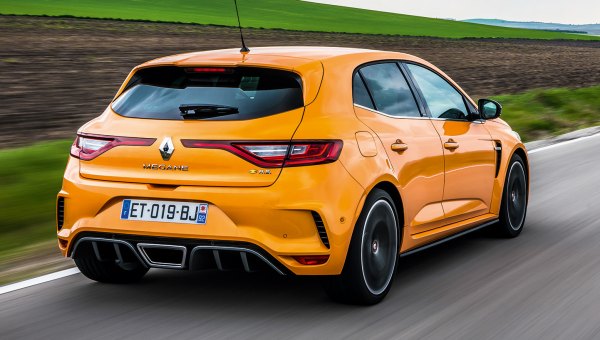
|
|
The
decision to use a smaller engine seems to be wrong – and I worry that
it will limit its development in the future...
|
|
Gearbox: an EDC
6-speed twin-clutch gearbox is available as option this time. This
wet-clutch unit is certainly better than the dry-clutch unit on Clio
RS, but in manual mode it is still too jerky and too slow to downshift.
It will upshift automatically in all but Race mode. Moreover, the shift
paddles are awkwardly placed and its feedback is poor. Therefore, the
standard 6-speed manual is the obvious choice. It is revised from the
old unit with a tighter gate and shorter throw shifter. While the
gearshift is not as sweet as Honda’s, it is more than decent.
Chassis: the Megane
IV is larger and runs a longer wheelbase. The RS is made larger still
thanks to widening its front and rear track by 60mm and 45mm
respectively. The old car’s trademark PerfoHub strut front suspension
is carried over to tame torque steer, while rear suspension is still
that torsion-beam axle. Strangely, Renault Sport rejected the class
norm of adaptive dampers. Instead, it uses hydraulic bump stops to
improve ride comfort. The ride height is lowered by 5mm and the
suspension settings are predictably stiffer than the lesser Meganes.
The standard RS is fitted with 235/40R18 tires and huge, 355mm front
brake discs with Brembo calipers.
Cup chassis: as
before, there is a Cup chassis option for more hardcore drivers. Its
suspension gets 30% stiffer springs, 25% stiffer dampers and 10%
stiffer anti-roll bars. 19-inch wheels and
245/35 tires are fitted, and a Torsen LSD is added to the front axle.
Lighter aluminum-hub compound brake discs are a further option.
4Control: as in the
lesser Megane GT, Renault's electrically-actuated rear-wheel steering
is fitted as standard, which is unique in the hot hatch class. It turns
the rear wheels in opposite direction by up to 2.7 degrees at low
speed, or up to 1 degree in the same direction at higher speed.
Normally this threshold happens at 37mph, but if you switch to Race
mode, it will be lifted to 62mph, so you can still enjoy the added
agility when you push hard.
On the road, the Megane RS gives a mixed impression. The engine is
about average. Honda Civic Type R has the best engine in the class.
Volkswagen group follows closely. The Renault engine is powerful enough
but not in the same league of them. It is not as free-revving or as
good to listening to either. Likewise, the performance is average in
the class. The decision to use a smaller engine seems to be wrong – and
I worry that it will limit its development in the future.
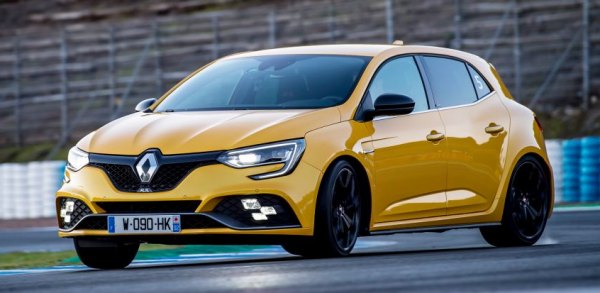
|
|
Its
biggest asset and also the biggest issue is the 4-wheel steering...
|
|
However, the old Megane RS was never outstanding in these two areas
either. Where it excelled was the chassis – keen to steer, perfect
balance, controllable oversteer and a transparent communication that
made you feel so involving and so confidence-inspiring to push it hard.
The new car is by no means lukewarm, but it seems to have lost the
final touch of the old car. Take the steering for example, the car
turns in faithfully, but the steering feels light. Dial through the
mode button will add weight to the steering, but not necessarily feel.
The body control of the car is expertly judged. On standard chassis,
its suspension feels firm but still soak up bumps effectively,
resulting in good composure (Cup chassis is too stiff for back roads
and more suitable to smooth roads or tracks). The grip is abundant, and
the braking is strong. However, when you call for communication, it is
mediocre.
Its biggest asset and also the biggest issue is the 4-wheel steering.
Attack a corner in Race mode, you will be amazed by the responsive
turn-in. The rear steers outward to tighten the line immediately. If
you are not used to its new found agility, you might think it is
oversteering. It makes tight corner easy, shortening turning radius and
relieving your work on the steering. To some extent, it feels unnatural
to hot hatch drivers. Maybe more time on the driver seat will overcome
that abrupt sensation, but some might find it too neutral, too
responsive to the extent of nervous, like driving a Ferrari F12tdf.
Your steering input has to be more measured. Overreact or lift off too
abruptly will unsettle the rear end in a fashion less progressive, less
controllable than the old Megane. As a result, it is not as intuitive
to
drive as a Civic Type R, Golf R or Leon Cupra.
The Cup chassis has tighter body control and more grip. Its LSD lets
you come back on power earlier in a tight corner thus should have been
the choice for very committed drivers. However, as its suspension is
too stiff, it is difficult to enjoy on back roads. Its composure does
improve at speed, but you need to push it very hard to enter its sweet
zone. Some hardcore drivers might like that, but they will find Civic
Type R better in just about every dynamic aspect except agility.
So it is disappointing to see the new Megane RS does not repeat the
magic of its predecessor or the excellent Alpine A110. It does things
differently thus has its own unique strengths, but
it is also less communicative, less forgiving and less
confidence-inspiring to drive. Will the upcoming Trophy or Trophy-R
save the game?
Let’s hope so, but I doubt.
|
Verdict:     |
Published
on 7
Dec 2018
|
All rights reserved.
|
|
Megane RS Trophy
|
|
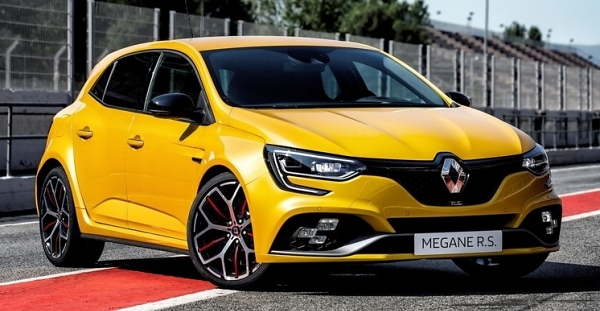
|
|
The
Trophy brings more power, but what it really needs is a more natural
balance.
|
|
The current Megane RS has
lost its hot hatch crown to Civic Type R. Can the latest Trophy version
regain the lost title?
The most noticeable change of the car is more power. While retaining
the downsized 1.8-liter turbo, it is given a faster-spinning
turbocharger that uses low-friction ceramic ball bearing. This boosts
its output by 20hp to a round 300hp. That’s 25hp more than the most
powerful version of the old Megane RS, but trails the Civic Type R by
20hp. After all, the Renault engine is not only smaller but also less
sophisticated than the VTEC-equipped Honda. In the torque side, it is
lifted by 22lbft to 310lbft and beats the Honda’s 295lbft. However,
this is only true to the car equipped with EDC twin-clutch gearbox,
which is less good than the standard 6-speed manual. With the latter,
the maximum torque is regulated at 295lbft to protect the gearbox. As a
result, the Trophy has no hope to match the Type R or Golf R in
straight line performance. It quotes a 0-60mph time of 5.4 seconds,
just a tenth down from the standard RS. Top speed is lifted from 158 to
162mph.
On the road, the small engine has good throttle response. Turbo lag is
not world-class but reasonably suppressed. It pulls hard from 2000rpm
thus flexibility is good. You can sense more mid-range torque than the
280hp engine. It is less noticeable at higher revs, but you will
definitely notice more noise from the exhaust, especially the pops and
crackles on overrun. This is because the exhaust has been fitted with
an electronic valve instead of the passive one on the standard car. It
keeps shut in Comfort mode, opens at above 4000rpm in Sport mode or
keeps opening all the time at Race mode. That said, I would rather
trade this artificial acoustic for the wonderful symphony of a VR6,
even sacrificing some performance in the process.
The EDC is not available yet, but from the experience of the RS, it
should be no match for Volkswagen’s DSG for speed and smoothness. The
manual gearbox is unchanged from the RS, so it is still a little
notchy, but is swift and generally satisfying.
The chassis of Trophy is basically the same as the RS fitted with
optional Cup package. It includes Torsen LSD, stiffer suspension
setting (30% stiffer springs, 25% stiffer damping and 10% stiffer
anti-roll bars) and 245/35R19 Bridgestone Potenza S001 tires. Also
fitted as standard are 355mm aluminum-hub front brake discs with Brembo
calipers and lightweight wheels. Together they save 11.6kg of unsprung
weight. Meanwhile, the class-unique 4-wheel steering system is kept, of
course. Those attending track days often may opt for even lighter
wheels and track-oriented Potenza S007 tires. Otherwise, the car is
just the same as the RS Cup.
In the cabin, the most significant change is the Recaro Alcantara
buckets, which are mounted 20mm lower for a slightly better driving
position.
On track, the Trophy is not a big departure from the Cup, predictably.
It is quick, certainly, and its 4WS gives it an amazing level of
agility. However, the 4WS is also its weakness, because it amplifies
oversteer. It sharpens the turn-in so much that you feel its rear
breaking lose and sliding, although it is actually not. You need to
learn trusting its rear grip, calm down and keep pushing on, then it
will straighten its nose. Ultimately, it corners quickly, but it could
feel nervous and unnatural. On a wet track, it could be even scary to
those not getting used to its new manner.
On B-roads, the Trophy feels better. Because you cannot push so hard on
road, and you are likely to skip Race and switch on Sport mode, which
lowers the rear-steer operating threshold from 62 to 37mph, the car
behaves more subtly, less edgy. The suspension is firm, undeniably, but
its hydraulic bump stops round off the worst bumps, while body control
is always tight. What it loses to the best rivals are the controls: the
steering could be more communicative, the brake pedal could be lighter
and the torque steer could be better suppressed. In addition to the
unnatural balance, the best Megane RS at the moment still has a long
list to sort out before it can regain its lost crown.
|
Verdict:     |
Published on 8
Feb 2020
|
All rights reserved.
|
|
Megane RS Trophy-R
|
|
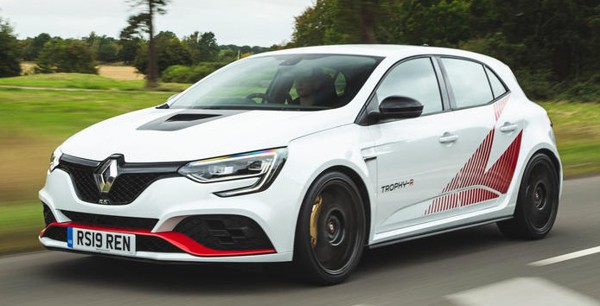
|
|
If
you get £72,000, would you buy a French hot hatch or a Porsche
GT4?
|
|
Having set a lap time of
7:40.1 at Nurburgring, the new Megane RS Trophy-R is currently the
fastest front-wheel-drive car lapping Nurburgring. It beats the last
record holder, Honda Civic Type R, by 3.7 seconds. Not a huge margin,
but considering the car runs a smaller and slightly less powerful
engine, and it lacks the Type R’s big wing, this is respectable.
However, from another perspective, it is not so remarkable. With a
price of £51,000, it is almost £20,000 more expensive than
the Type R or the standard Trophy. Yet that is the starting point. To
get the same specifications that set the Nurburgring lap record, you
need to tick a couple of very expensive options, i.e. carbon-fiber
wheels and carbon-ceramic brakes. Then you will find it ends up at
£72,000, the same money as a brand-new Porsche 718 GT4 or Spyder.
The Porsche is quicker, but even without considering its superior
straight line speed or 10-seconds advantage in Nurburgring, I guess no
one would compare a French hot hatch with the most prestigious and
entertaining German mid-engined sports car. Isn’t Renaultsport a bit
crazy?
If this car was converted to six-cylinder power and exotic mid-engined
layout like the old Renault Sport Clio V6, it might be worth
considering. However, when it employs the same 300hp 1.8 turbo engine
from the lesser Trophy, even the wealthiest car enthusiasts should
think twice. What makes this car so expensive? and what makes it
superior to the lesser cars? The answer lies on 3 areas: weight
reduction, new suspension and upgraded aero.
In the most exotic form, the Trophy-R is 130kg lighter than the Trophy.
Weight savings are both extensive and aggressive. In the cabin, it
replaces the front seats with Sabelt composite racing buckets (-14kg),
ditches the rear seat altogether (-25kg), reduces sound deadening
materials and even turns to a smaller touchscreen, although the crucial
air-con and audio escape from the axe. At the body shell, the bonnet is
now a mix of carbon-fiber and glass-fiber composites (-7kg). The rear
diffuser is fully made of carbon-fiber (-2.3kg). The side windows get
thinner, and the rear one is fixed, saving electric mechanism. The rear
screen wiper is gone (-3kg). The boot floor gets thinner (and more
fragile). At the chassis, the bespoke torsion-beam rear axle is not
only lighter but it gets rid of 4Control rear-wheel steering mechanism,
together saving a valuable 32kg. The remaining savings come from
Akrapovi titanium exhaust (-6kg), a lithium battery (-4.5kg), the
aforementioned carbon-fiber wheels (16kg) and ceramic brakes.
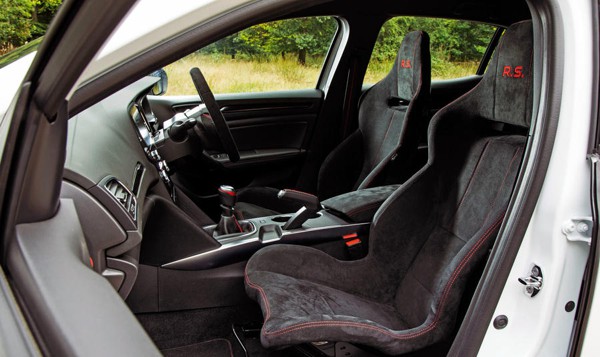
|
|
130
kg of weight is shaved, most come from the spartan interior.
|
|
Upgrades to the aerodynamics is most obvious at the new bonnet, which
gets 2 louvered vents sandwiching a NACA duct in the middle. They
improve engine cooling and release pressure built up in the engine
compartment. Less obvious is underneath the car. There are extra
underbody paneling to smooth out air flow, to cool the brakes, and to
draw more air towards the rear diffusers. The latter gets larger,
curvier and more effective, thanks in part to the recessed exhaust. The
result is more downforce and minimal increase of drag.
Ditching the active rear-wheel steering might sound like a backward
movement, but remember, many keen drivers dislike its unnatural
response. Moreover, the Trophy-R compensates with Ohlins 2-way
adjustable dampers at all corners. With some work in the garage, you
can alter its compression, rebound and ride height (by 16mm). The front
wheels get more negative camber. The rear suspensions are reinforced by
fitting a strut brace, which occupies the space left by the rear seat.
Finally, the Bridgestone Potenza S007 rubbers with bespoke compound
offer more grip yet respectable durability.
Powertrain is the weakest link of the Trophy-R. Renault has never been
renowned for engines (although it made some championship-winning F1
engines for Williams). When it asks its engineers to make a 1.8-liter
as good as the 2-liter counterparts of Honda and Volkswagen, it is
simply a mission impossible. Despite producing a similar level of power
and torque, the 1.8-liter unit has a compromised manner. Running a
larger turbo and higher boost means the mid-range is strong enough, but
low-end response is soft, with more turbo lag than its rivals.
Meanwhile, the undersquare combustion chambers (79.7 x 90.1 mm)
contribute to an unwilling top-end. It lacks the free-revving, going
stronger and stronger character of Honda. The unchanged 6-speed manual
gearbox is similar. Gearshift is notchy and imprecise, a sharp contrast
to the first class unit of Honda. Coupling to the Megane’s flawed
ergonomics – poor positioning of gearlever and pedals, there is little
joy to row the shifter and access the engine spectrum.
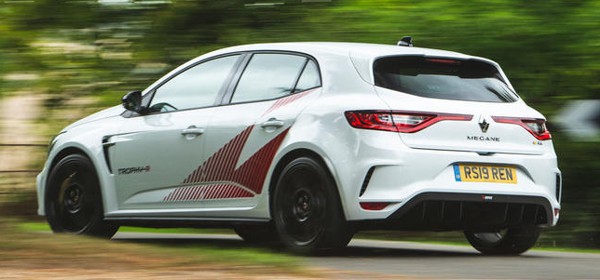 |
|
The
fast Megane has lost its limelight, undeniably, but the French hasn’t.
|
|
On straight, the car also trails Civic Type R and Golf R a little,
although its performance claim of 163 mph top speed and 5.1 seconds for
0-60 seem competitive. We should expect 4 seconds flat for a
£50,000 hot hatch, as shown by AMG A45 and Audi RS3.
Fortunately, what the Trophy-R loses in straight line performance, it
gets back in corners. There is no denying the strong influence of 130
kg of weight savings, but the Ohlins dampers are equally effective.
Given adequate adjustment, the Trophy-R can eat any hot hatches for
breakfast on a racing track. It displays sharp turn-in, very strong
front-end grip and the car is very tied down to the road. It corners
flatter than anything else, and the cornering limit is incredibly high
for its class. The steering is accurate and, most important, it relays
all the information from the track surface, from the state of grip and
cornering force to your fingers, thanks to the stiff suspension setup.
Torque steer is not fully eliminated, but Renaultsport’s PerfoHub
suspension keeps it in check so that it never spoils the experience.
Most impressive is the precision the car displays, allowing you to
place it accurately to each apex. If not the powertrain, this could be
the front-engined 911 GT3 RS.
However, the flipside of immense grip and outstanding stability is the
lost of adjustability. Its cornering limit is so high that throttle
steer is difficult to access, even on a track. As a result, it is not
as much fun to drive as the old RS 275 Trophy (R or not), or to lesser
extent the current Civic Type R. A highly precise tool to attack
corners, but not necessarily the most entertaining.
For road use, you need to adjust the suspension to middle settings to
avoid rocking your eyeballs off. So adjusted, the Trophy-R could be
livable, if still not as livable as Type R. The ride is more hardcore
than most other hot hatches, but it deals with bumps and potholes
reasonably well. The thinly insulated cabin is a bit noisier than hot
hatch norm, but not overly noisy. The titanium exhaust pops and
crackles on overrun, but it is a welcomed noise. The Sabelt racing
buckets are not quite as comfortable as the Recaro buckets on Honda.
The loss of rear seat is perhaps the car’s biggest drawback. It makes
you wonder why not buy an Alpine A110 instead. That little mid-engined
sports car is the purest and most entertaining driving machine in the
world today (even Gordon Murray could not help amazing), and it comes
from the same Dieppe factory! The fast Megane has lost its limelight,
undeniably, but the French hasn’t.
|
Verdict:     |
|